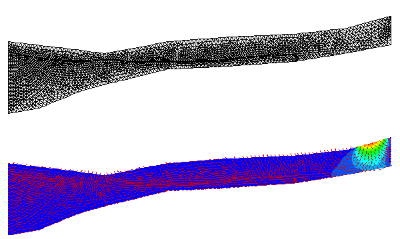ESTEL
ESTEL, groundwater hydrology model
Contact: Malcolm Anderson
Description
ESTEL is a groundwater flow and contaminant transport model developed in partnership with the Research and Development unit at Electricité de France. ESTEL has been used for applications ranging from hillslope hydrology to the study of nuclear waste disposal (see the examples below). Two versions of the model are available: ESTEL-2D and ESTEL-3D.
- ESTEL-2D solves Richards' equation by the the finite element method on two-dimensional unstructured meshes of triangles. It also solves the advection-dispersion equation (transport module) by the control volume finite method and can track particles with the Fokker-Plank equation (particle tracking module).
- ESTEL-3D solves Richards equation by the finite element method on three-dimensional unstructured meshes of tetrahedra and can track particles moving according to the the Fokker-Plank equation. Fractured aquifers can be modelled using a dual-continuum approach. ESTEL-3D can also be coupled to the flood inundation model TELEMAC-2D to link subsurface flow to surface flow.
Selected Applications
The following examples illustrate some of the capabilities of ESTEL:
Hillslope Hydrology
The hydrology group uses ESTEL to study hillslope hydrological processes. In this particular example, ESTEL-2D was used with various plausible model set-ups (initial conditions, boundary conditions, soil types) to understand how the modelled dynamics of the hydrological system are affected by modelling decisions.
Slope Stability
In this particular example, ESTEL-2D was used to understand how the water pressure evolves behind an undrained retaining wall during heavy rainfall in Hong Kong. In particular, it was discovered that after roughly 3 hours of rainfall, the perched water table created by infiltration and the deep water table started to connect which could cause problems for the stability of the retaining wall.
Nuclear Waste Disposal
At EDF, ESTEL-2D and ESTEL-3D are used to understand and evaluate the migration of radio nucleids from a deep nuclear waste disposal site for hundreds of thousands of years. The results are regularly benchmarked against other groundwater models. This work is of great importance to be able to design and build nuclear waste disposal sites that will be safe for generations.
Floodplain Hydrology
The Hydrological research Group has an instrumented field site on the floodplain of the river Severn, Shropshire, UK. ESTEL-2D was used to model the infiltration of a flood in the floodplain and the results showed very good agreements with the measured data.
Key staff
JP Renaud (Bristol University)
Regina Nebauer (EDF R&D)
Fabien Decung (EDF R&D)
François Dumortier (EDF R&D)
Hannah Cloke (King's College, London)
Minh-Phuong Lam (PhD student Institut de Mécanique des fluides de Toulouse and EDF R&D)
Sylvain Aunay (PhD student Centre d'Informatique Géologique and EDF R&D)
Availability
ESTEL-2D and ESTEL-3D are part of the TELEMAC system. ESTEL actually stand for "Ecoulements Souterrains dans TELEMAC" which means "groundwater flow in TELEMAC". ESTEL is available commercially from the distributors of the TELEMAC system. Research licenses are also available.
External links
EDF R&D
King's College Geography Department
Telemac System
Institut de Mécanique des fluides de Toulouse
Centre d'Informatique Géologique
Copyright
ESTEL and TELEMAC are Copyright© EDF 1997-2008




